Reflections on the Canadian Grand Prix
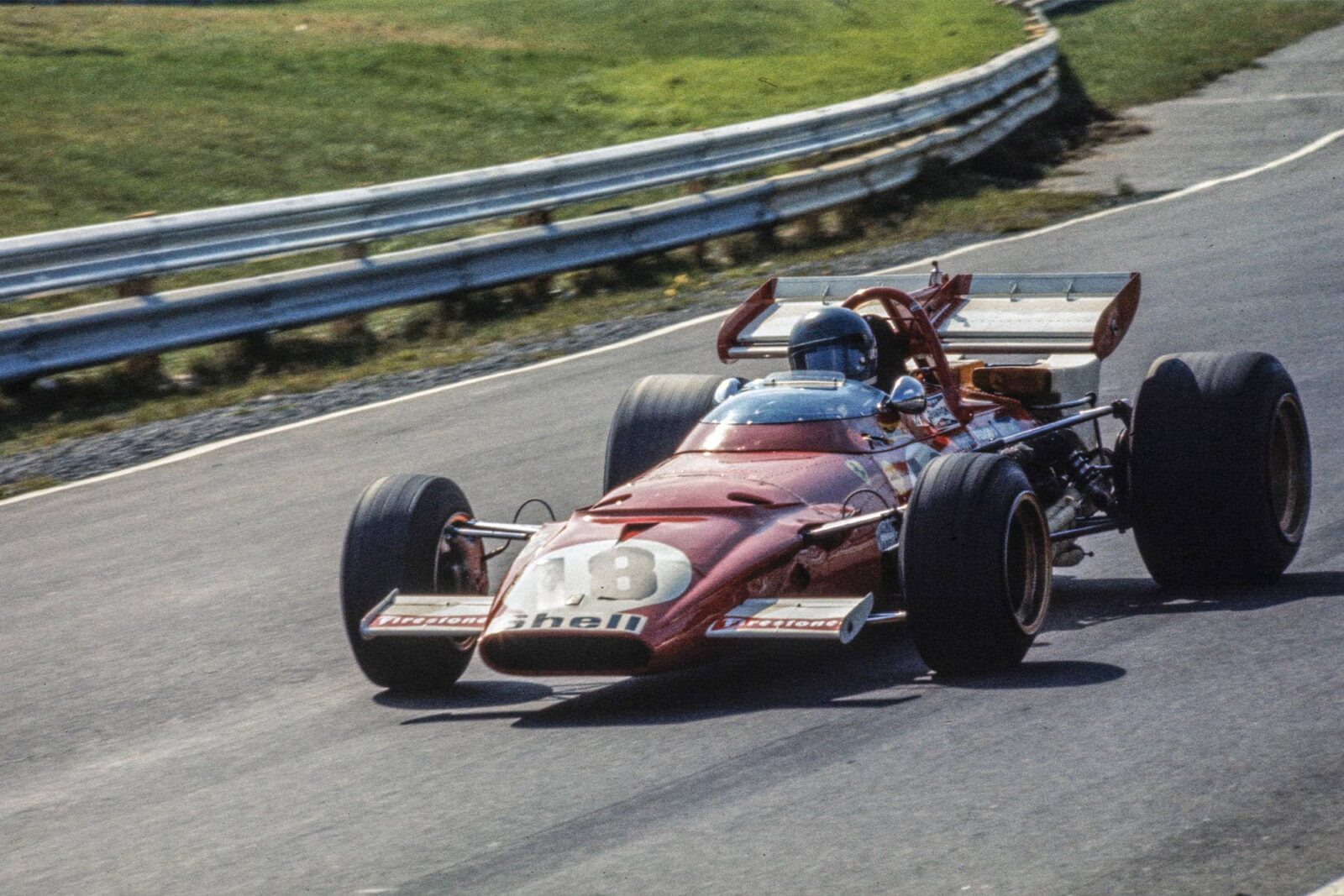
Jacky Ickx took his second win of the season in Canada
Motorsport Images
I do not know who first used the word “circus” when referring to the Grand Prix teams and their movements around the world; in fact, it may have been me, for many years ago I joined an elite group of racing motorcyclists from England who were known as the “Continental Circus”. This was because we set off at the beginning of the season, loaded with equipment and spares, and toured Europe. racing every weekend, and returning home at the end of the season richer or poorer depending on our success, but always with a satisfying store of experience and knowledge. Starting-money and prize-money pail the expenses between races, so that sometimes we could afford to stay in hotels, other times we had to sleep in a tent. The word “circus” has been applied to the Grand Prix scene and I feel it has a very different meaning, for no team goes “on tour” Sunday after Sunday, it is a matter of race and return to base immediately. Since the inception of three Grand Prix races on the west side of the Atlantic ocean, one in Canada, one in the United States and one in Mexico, the name “circus” really does apply to the Grand Prix scene, for apart from top personnel and the drivers, the teams and equipment are gone for five or six weeks “on tour” in the New World.
This was brought home very forcibly when I went into the paddock at the Mont Tremblant-St. Jovite circuit, for there was a huge striped circus tent, long and narrow, with a fence keeping the spectators back, and at one end were the lions roaring gently to themselves, at the other end the tigers snarling menacingly, in the middle the elephants trumpeting loudly and all around, mingling with the keepers, were the clowns. The circus had come to town and, as in European countries, it heralded the arrival of autumn and the approach of winter. The performers put on their show in the Canadian playground of Mont Tremblant, a couple of hours north from Montreal, and then everything was packed up, loaded onto five huge transporters and taken on to the next country for a repeat performance before another audience. Due to it not yet being a completely united circus and lacking a powerful “ring-master”, some of the acts arrived in Canada in a disorganised state while others were well prepared. The Ferrari team stood slightly aloof from all this, having their two cars and all their equipment in a big enclosed transporter of their own, and were packed up and gone on the Monday morning after the race while the “circus” was being loaded onto open transporters
The Canadian Grand Prix is only four years old, twice being held at Mosport and twice at St. Jovite, and judging by the small crowd that attended the 1970 race the word has not really got through that the European Circus was coming to town. Fortunately the financial loss was made good by the Imperial Tobacco Company, and more fortunate is the fact that people do not heed the dire warnings of the medical profession, and continue to smoke Player’s cigarettes in sufficient numbers to allow the profits to be spent on supporting money-losing motor races. I am told this is called sponsorship, which sounds like a cover-up for a business failure. As with many countries the venue for the Grand Prix alternates between two circuits, in the Canadian case between Mosport and Mont Tremblant-St. Jovite, and the 1970 race was held at the latter. It is a nice little circuit, carved out of forest land and undulates in quite a spectacular manner in places, and is 2.65 miles to the lap, being something of a cross between Oulton Park and Brands Hatch, and is run on very European lines. It is in the area of Mont Tremblant. a winter-sports resort that is also part of an all-the-year-round playground for the French-Canadians of the Province of Quebec, activities including light aircraft flying, gliding, horse-riding, boating, fishing, camping and so on, and driving north from Montreal the Mnnt Tremblant area is just about at the end-of-the-road. St. Jovite is the nearest sizeable village to the Mont Tremblant park.
Qualifying
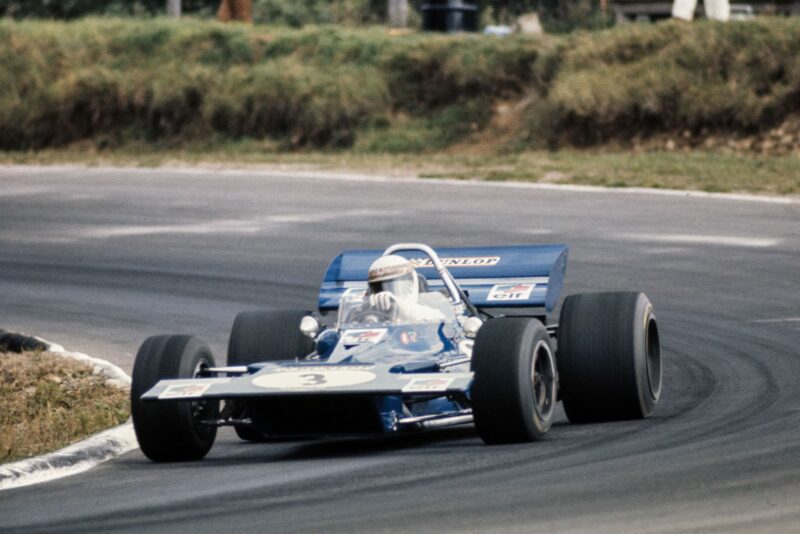
Jackie Stewart took pole
Motorsport Images
Nowadays it is fashionable for the “circus” to talk before getting on with the act, and shrill cries could be heard complaining that the track surface was awfully rippled and bumpy, but the cries were not unanimous. One top driver grinned and remarked quietly that they would “have to find out where the bumps were and dodge them, wouldn’t they”. Another one, an ex-motorcyclist, said they would have to grip the tank between their knees and stand up on the footrests over the bumps! A further moan was about the length of the race, 90 laps of the 2.65-mile circuit, every bit of 238.5 miles (383 kilometres) and, what was worse, it was going to run for more than 2-1/4 hours. Those who regularly take part in 1,000-kilometre and 12-hour or 23-hour sports-car races were not too impressed by the complaints. A number-of “designers” and “technicians” seemed to doubt whether their cars would keep going for more than two hours, but in spite of that they all took part in the fourteen hours of practice that was available over the three days before the race. Some of their misgivings proved true; Brabham had a front wishbone break on Stomrnelen’s car when he was driving it in practice, the wheel lent backwards, locking the steering, and the car went straight on into an earth bank. Luckily Brabham had not been going desperately fast when it happened so he got away unscathed, but a lot of work had to be done by the Brahham mechanics to straighten it all. Amon’s March collapsed when a rear hub upright casting broke in practice and Cevert’s March broke a shock-absorber in the race. Stewart’s March had a rear hub bearing break up which brought the car to a grinding halt, while his new Tyrrell car had a rear wheel hub nut work lose, in practice, and the subsequent exciting moments would have put most drivers right off, but the Scot was undeterred, and in the race the Tyrrell broke a front stub axle. Oliver’s BRM broke a rear wishbone during the race and the De Tomaso broke a rear shock-absorber, while Hill’s Lotus 72 had a rear wishbone mounting plate come loose during the race due to the bolts not having been tightened properly, and this resulted in the top suspension cross-member breaking, and Ferrari found a cracked front brake disc on the lckx car during practice, so that all told it would seem that the Grand Prix design and maintenance world could stand looking into by those who are worried about safety in motor racing.
The Canadian organisation was very realistic during practice, which ran continuously throughout the afternoons of Thursday, Friday and Saturday, for every now and then practice would be stopped to allow the official breakdown lorry to go round the circuit and collect any car that had broken down. It was an amusing pastime to notice which set of mechanics and technical people were on the lorry as it went round the circuit, thus indicating who was missing, and this was useful if you were spectating away from the pits. One time it would have the Tyrrell mechanics on board, then a group of BRM mechanics and a Dunlop man, then the Matra people, and so on. Too many race organisers refuse to stop practice once it has started, so that if a car breaks down on the far side of the circuit it has to stay there until the end of the afternoon. Worst offenders are the Nurburgring where practice for a supporting race follows Grand Prix practice immediately, so that a car may stop on its first Grand Prix practice lap and be stuck miles away until the end of the day. Few organisers make any allowance at all for mechanical failure, be it a broken crankshaft or a broken suspension, but the Canadians budgeted for these sort of failures in their practice programme. They had supporting races, but all their practice was in the mornings, so that from lunch-time onwards all the time was at the disposal of the “visiting circus”. At the end of practice and before the start of the race there was the sort of muddle that should have involved the Ferrari team, but in fact involved Tyrrell and Stewart and the race organisation. Grid positions were allocated numbers starting at 1 for pole position and 20 for the slowest man, instead of by row number one to row number ten, as is more normal. Now Stewart’s March was race number 1 and his Tyrrell was race number 3, and at the end of practice he had qualified the Tyrrell as fastest and the March as third fastest. Somewhere along the line on Saturday evening, when Ken Tyrrell nominated his car for the race, he said he was starting number one, meaning position number one, and someone thought he meant car number one, which was position number three. Those of us who were watching the Tyrrell car being prepared knew that it was going to be used for the race, but someone in the office doing the paperwork for the starting grid put Stewart in car number 1, which was the March in position three, and neither party realised the mistake until Sunday morning, when the published grid showed the two Ferraris on the front row. The muddle was resolved without too much fuss, the Tyrrell put on the front row in pole position, Ickx moved sideways and Regazzoni moved back to row two. It really was a chance in a thousand that cars number 3 and 1 should make first and third qualifying times.
Apart from the way Stewart pulled fastest practice lap right at the end of Saturday afternoon, and ran away from the opposition until his car collapsed in the race, all of which you would expect from a World Champion, his young French team-mate was undoubtedly the star turn of the whole meeting. During practice the Tyrrell car was keeping everyone very busy so that Francoise Cevert did not receive too much attention. On the first afternoon his practice was stopped abruptly when the ring of bolts holding the flywheel to the crankshaft flange all sheared and left the car with no drive. After that was put right he began to press on very forcibly and, watching him on some of the more difficult parts of the circuit, he was being very brave and courageous, and I hoped he had sufficient skill to cope with his bravery. He finished up practice with fifth fastest practice time and fourth position on the grid as Stewart had two cars in the first five, so that he only had his team-leader and the two Ferraris in front of him. For a “first-year boy” in Grand Prix racing he could hardly hope for more, except, of course, the Ferrari just ahead of him was also driven by a “first-year boy”, namely Regazzoni, and his record in one season has confounded everyone. For some time now the trade barons who control racing drivers’ destinies and those well-known people “the pundits” have been asking where the new talent for GP racing was coming from. I never heard any of them suggest France and Switzerland, though I got very tired of hearing about Peterson, Schenken, Wissell, Fittipaldi and Gethin.
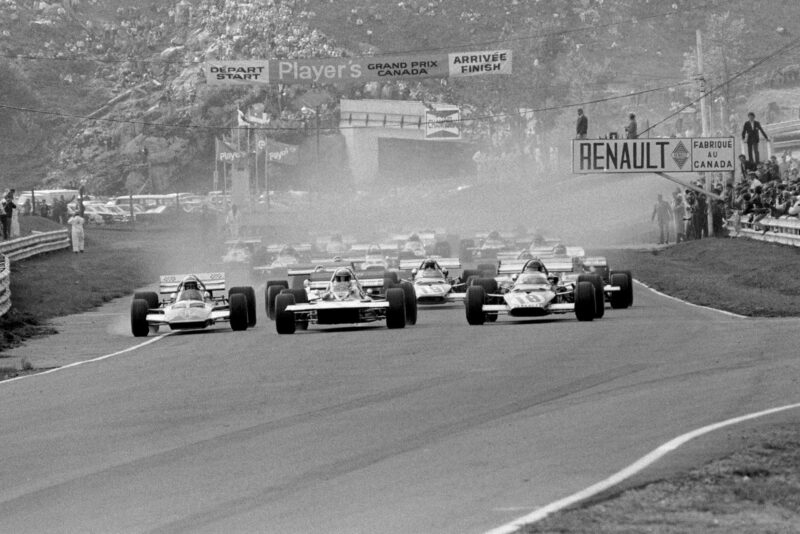
Stewart leads at the race start
Motorsport Images
In the race Cevert showed that his grid position was not due to a single lucky fast lap, or a time-keeping error, as Pescarolo’s would appear to have been, for he pressed Amon really hard all the time and would have been a certain fourth and a possible third if a shock-absorber had not broken on his March. In addition to that he made the third fastest lap in the race at 1 min. 32.8 sec., against 1 min. 32.6 sec. for lckx and 1 min. 32.2 sec. for Regazzoni (that new-boy again). Cevert was not only the fastest driver of a Cosworth V8 engine in the race, but the only one to break 1 min. 33.0 sec. Having been thrown in at the deep end last June he is learning to swim very well.
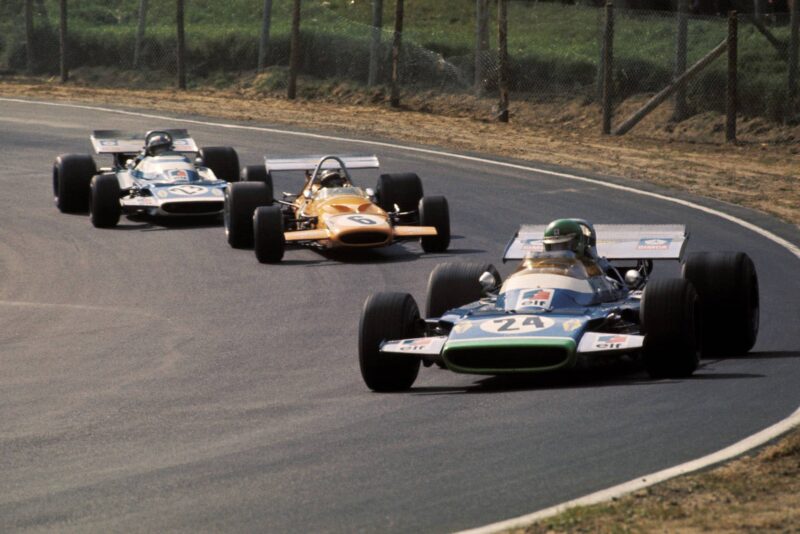
Pescarlo leads the midfield pack
Motorsport Images
For those who like the sound of 12-cylinder engines the Canadian GP was very satisfying for seven of them started the race and all seven were running at the end, even though the official results did not classify Oliver’s BRM as it was too many laps behind, due to the long stop to repair the rear suspension. It was thought that Beltoise might react to local enthusiasm the way he did at Clermont-Ferrand, for the Province of Quebec is much more French than Canadian; the peculiar brand of French spoken by the locals was almost unintelligible to the members of the French Matra team and was more easily understood by English people whose French is pretty poor, so that Beltoise felt as if he was in a foreign country rather than in his homeland.
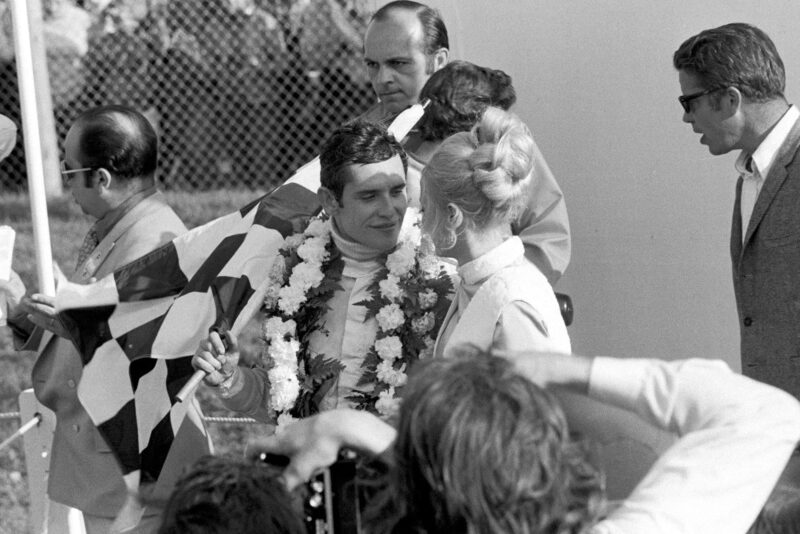
Ickx celebrates on the podium
Motorsport Images
The day after the Grand Prix the rains came down in a big way and the loading of the cars on to the transporters to take them to Watkins Glen had to be abandoned. The big articulated GMC trucks could carry five cars apiece and the loading was carefully arranged amongst the five vehicles so that no team had more than one car on a transporter, just in case of a disaster on the road. The company doing the job were Howard Sober Inc. of Lansing, Michigan, possibly the oldest transport firm in the United States, and the only one that an insurance company would give cover for, with a £100,000 load on board each vehicle. Since the inception of the “package deal” Grand Prix events in the New World, ten years ago, this firm has always looked after the mass movements, only Ferrari opting out and using a transporter of their own.—D. S. J.
